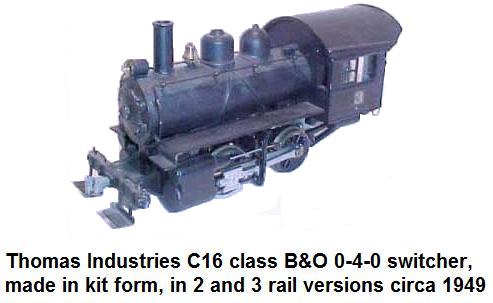 Thomas Industries was founded in the post WWII 1940's by Jim Thomas in Wenonah, NJ to create a line of
'O' gauge scale and tinplate trains, as well as scale model builder's power tools and scientific instruments.
Jim Thomas had a long career in train manufacturing having been one of the original founding partners, along with
John Tyler, of Mantua Metal Manufacturing, a maker of electric motors, toys and electric trains
that got its start in model train making during the 1930's. The original plans for Thomas Industries
included manufacturing of 'O' gauge kits.
Thomas Industries was founded in the post WWII 1940's by Jim Thomas in Wenonah, NJ to create a line of
'O' gauge scale and tinplate trains, as well as scale model builder's power tools and scientific instruments.
Jim Thomas had a long career in train manufacturing having been one of the original founding partners, along with
John Tyler, of Mantua Metal Manufacturing, a maker of electric motors, toys and electric trains
that got its start in model train making during the 1930's. The original plans for Thomas Industries
included manufacturing of 'O' gauge kits.
 The first product manufactured by Thomas Industries was a C16 class 0-4-0 steam locomotive based on the
Baltimore & Ohio prototype from the 1900's. The loco was powered by a Pittman worm driven motor designed by Jim Thomas that
was completely concealed in the loco's firebox. Thomas was good friends with Charles A. Pittman, owner of the Pittman Electric
Development Company of Sellersville, PA which was famous for supplying many manufacturers with electric motors for their model trains.
The engine was offered in kit form with a slope back tender for $29.50. This smaller 0-4-0 locomotive helped train enthusiasts that
lived in cramped houses overcome the challenges of layout space that plagued many 'O' gauge operators of the time period.
The first product manufactured by Thomas Industries was a C16 class 0-4-0 steam locomotive based on the
Baltimore & Ohio prototype from the 1900's. The loco was powered by a Pittman worm driven motor designed by Jim Thomas that
was completely concealed in the loco's firebox. Thomas was good friends with Charles A. Pittman, owner of the Pittman Electric
Development Company of Sellersville, PA which was famous for supplying many manufacturers with electric motors for their model trains.
The engine was offered in kit form with a slope back tender for $29.50. This smaller 0-4-0 locomotive helped train enthusiasts that
lived in cramped houses overcome the challenges of layout space that plagued many 'O' gauge operators of the time period.
 Thomas followed the 0-4-0 with a 2-8-0 consolidation. The consolidation was 'O' scale and designed for 2-rail
operation. This engine was featured as the cover illustration on the November 1950 issue of Model Railroader magazine.
It included a tender and sold for $48.50 as a complete kit. It could also be acquired as an 0-8-0 for
$44.00. These locomotives demonstrated a
high level of design and engineering, employing sheet metal boilers, die-cast zinc alloy boiler fronts and
cabs, sprung drivers, cast-brass cylinders and main frames, turned brass smokestacks, brass headlights and
bells, and the Pittman electric motors. The locomotive's moving parts were machined to 1/5000 of an inch tolerances.
These models were respected for their looks and performance by hobbyists. Thomas advertised their models as,
"...easy to build and easy to buy!"
Thomas followed the 0-4-0 with a 2-8-0 consolidation. The consolidation was 'O' scale and designed for 2-rail
operation. This engine was featured as the cover illustration on the November 1950 issue of Model Railroader magazine.
It included a tender and sold for $48.50 as a complete kit. It could also be acquired as an 0-8-0 for
$44.00. These locomotives demonstrated a
high level of design and engineering, employing sheet metal boilers, die-cast zinc alloy boiler fronts and
cabs, sprung drivers, cast-brass cylinders and main frames, turned brass smokestacks, brass headlights and
bells, and the Pittman electric motors. The locomotive's moving parts were machined to 1/5000 of an inch tolerances.
These models were respected for their looks and performance by hobbyists. Thomas advertised their models as,
"...easy to build and easy to buy!"
 Unfortunately, sales of these scale products were just so-so. In the late 1940's the scale model
builder market declined greatly. Hobbyists no longer had the time to spend building models, and the big toy manufacturers such
as Lionel and American Flyer were now making more scale-like prototypical ready-to-run trains that
appealed greatly to consumers. Plus the popularity of HO scale models was eclipsing that of the 'O' gauge with hobbyists.
Thomas' goal of making and selling scale modeler's building tools such as sander machines, arbor presses, and brakes for bending
metal was never accomplished. Instead Thomas concentrated its efforts on making steam castings, bridge components and machined parts that were
employed by other manufacturers and the small model builder and hobbyist market. Thomas Industries manufactured the die cast body sides and ends
for the Pittman 'O' gauge streetcars from 1949 through 1951. Jim Thomas also made parts for the 'O' gauge Minitoy trolleys of the same period.
Unfortunately, sales of these scale products were just so-so. In the late 1940's the scale model
builder market declined greatly. Hobbyists no longer had the time to spend building models, and the big toy manufacturers such
as Lionel and American Flyer were now making more scale-like prototypical ready-to-run trains that
appealed greatly to consumers. Plus the popularity of HO scale models was eclipsing that of the 'O' gauge with hobbyists.
Thomas' goal of making and selling scale modeler's building tools such as sander machines, arbor presses, and brakes for bending
metal was never accomplished. Instead Thomas concentrated its efforts on making steam castings, bridge components and machined parts that were
employed by other manufacturers and the small model builder and hobbyist market. Thomas Industries manufactured the die cast body sides and ends
for the Pittman 'O' gauge streetcars from 1949 through 1951. Jim Thomas also made parts for the 'O' gauge Minitoy trolleys of the same period.
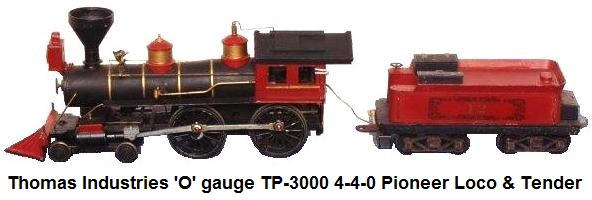 By the 1950's, Thomas had changed its direction to modeling 19th century trains. Thomas
Industries succeeded in producing an 1860's era General type steam locomotive and set almost a decade before
Lionel did. They released the TP-3000 4-4-0 engines and the freight/passenger cars
in tinplate to go with these locos as ready-to-run sets in 1951. The locos were generic in appearance, but
included red painted cow-catchers, detailed sand domes, a square shaped headlamp, simulated whistle and bell in
brass. It was a 15½ inch scale model. The locomotive boasted a worm drive Pittman motor. Offered were
models with a cabbage stack (wood burner) and a straight stack (they called it the
Branchline) coal burner. There was a passenger set, called the Shawnee Express, and a freight set
called the Shawnee Fast Freight. The Shawnee Express set was priced at $29.95. The locomotive and tender
looked very protoypical teamed up with a consist of Thomas’s 'O' gauge rolling stock such as the 7½ inch
TP-1006 tinplate flatcar or the scale wood-sided TP-1007 Wabash and Frisco gondolas. The loco by
itself was priced at less than $6.00.
By the 1950's, Thomas had changed its direction to modeling 19th century trains. Thomas
Industries succeeded in producing an 1860's era General type steam locomotive and set almost a decade before
Lionel did. They released the TP-3000 4-4-0 engines and the freight/passenger cars
in tinplate to go with these locos as ready-to-run sets in 1951. The locos were generic in appearance, but
included red painted cow-catchers, detailed sand domes, a square shaped headlamp, simulated whistle and bell in
brass. It was a 15½ inch scale model. The locomotive boasted a worm drive Pittman motor. Offered were
models with a cabbage stack (wood burner) and a straight stack (they called it the
Branchline) coal burner. There was a passenger set, called the Shawnee Express, and a freight set
called the Shawnee Fast Freight. The Shawnee Express set was priced at $29.95. The locomotive and tender
looked very protoypical teamed up with a consist of Thomas’s 'O' gauge rolling stock such as the 7½ inch
TP-1006 tinplate flatcar or the scale wood-sided TP-1007 Wabash and Frisco gondolas. The loco by
itself was priced at less than $6.00.
Their passenger cars and freight cars predated Lionel's offerings representing
this time period by several years.
Some say Lionel got religon because of what Thomas made and sold. No whistle or smoke was offered but these
trains sold well and were noticeably less expensive than Lionel's offerings. It is unknown whether Thomas
intended to compete directly with Lionel, as at the time, Lionel was concentrating on making contemporary models
of motive power prototypes. Thomas fitted their trains with knuckle couplers to make them compatible with
Lionel products. Jack Ferris of AMT liked the knuckle couplers so much that he put them
on his AMT cars also.

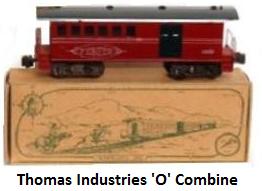
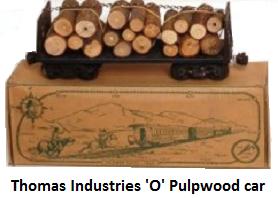
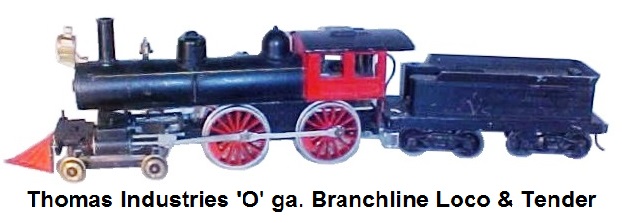 Thomas advertised their old time trains as a model that could "become the pride of
your Lionel layout". The passenger cars that came with the General set were referred to as Pioneer cars.
They were constructed of sheet steel and priced at $5.50 each. The Pioneer line offered a TP-1002 coach,
a TP-1005 combine, and a TP-1004 baggage car. Each came in three color combinations: yellow body, red trucks
and roof, green body, red trucks and roof, or red body, green trucks and roof. The coach and the combine
featured removable roofs for adding detail to the interior.
The Thomas old-time coach was originally produced at the Wenonah, NJ. factory with the word 'Pioneer' on the
side. By the middle of 1951 the year '1869' was added to either side of the word Pioneer. Coaches also exist
without any letters or numerals on the sides. Later production runs had simulated wood battans. There are
26 known variations of the Pioneer coach, 13 variations of the combine car, and 12 variations of the
baggage car.
Thomas advertised their old time trains as a model that could "become the pride of
your Lionel layout". The passenger cars that came with the General set were referred to as Pioneer cars.
They were constructed of sheet steel and priced at $5.50 each. The Pioneer line offered a TP-1002 coach,
a TP-1005 combine, and a TP-1004 baggage car. Each came in three color combinations: yellow body, red trucks
and roof, green body, red trucks and roof, or red body, green trucks and roof. The coach and the combine
featured removable roofs for adding detail to the interior.
The Thomas old-time coach was originally produced at the Wenonah, NJ. factory with the word 'Pioneer' on the
side. By the middle of 1951 the year '1869' was added to either side of the word Pioneer. Coaches also exist
without any letters or numerals on the sides. Later production runs had simulated wood battans. There are
26 known variations of the Pioneer coach, 13 variations of the combine car, and 12 variations of the
baggage car.

'O' gauge Freight car kits made by Thomas Industries were a Pulpwood car (1951), Steel Flat car (1952), Gondola,
old time Reading RR 4-Wheel Caboose (1950), Crane car (1952), and single-dome (1949), triple dome (1949), and 6 dome (1949)
Tank cars. The 3-dome tank cars were first made in 1949, once again predating Lionel's release of an 'O' gauge 3-dome tank
car by 4 years. The Thomas Industries tank cars featured operating dome lids. The pulwood car sold for $4.75, the flat car was
$4.50, the crane car was $5.50. The #TC-106 6-dome tank car kit was promoted as a wine car decorated for Roma Wine and
sold for $7.75. Thomas freight cars were painted by H & H Body Shop of Shawnee.
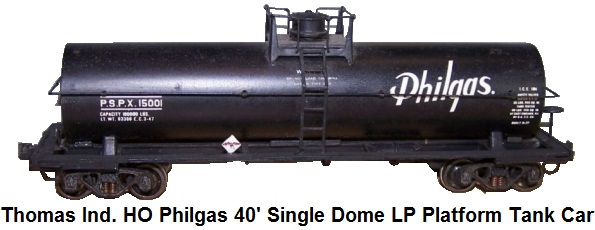
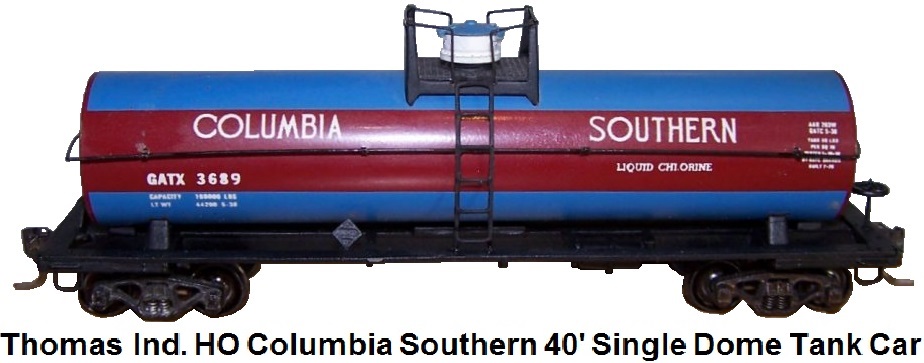 In 1951 Thomas acquired Scale-Craft and Company's line of 'O' gauge cars and moved
to a new facility in Shawnee, OK at 1125 E. Independence Street. The acquisition encompassed the Scale-Craft dies and equipment to
manufacture nine freight car kits. This included a 40' 6 inch box car, a 40 ton stock car, a 50 ton twin
hopper, a 70 ton gondola, a milk tank car, a Passenger Express Refrigerator car, and maintenance work car.
These freight car kits were available from 1951 to 1960. The 1952 catalog of Thomas Industries Trains
was 12 pages and contained black and white photos of the trains being offered. In the mid-1950's Thomas Industries
also released HO gauge tank car kits and in 1951 a set of hand painted 20mm HO Civil War era lead figures, designed and produced by Jim Thomas' son James Jr.
When Jim Thomas sold his half of Mantua to his brother-in-law John Tyler, he agreed to refrain from making and selling HO gauge products. The agreement expired in 1955.
The HO tank car kits now produced by Thomas Industries featured single dome as well as 6
dome tanks. The tank cars were formed sheet steel, with cast white metal underframes, tank ends, and domes. Smaller parts were all metal.
Some of the single dome cars were offered with platforms. The single dome cars sold for $2.95, the
single dome with platform sold for $3.75, and the 6 dome cars sold for $4.35. The cars were all metal and
featured sprung trucks. They came pre-painted in several different road names and colors, including DX Sunray Oil, Anderson-Prichard
Oil Corp. (APCO), Sinclair Oil Co., Magnolia Chemicals, and Matheson Chemicals. The platform tanks cars were decorated for Philgas Oil,
Sinclair Oil Co., Columbia Southern and Baker's Chocolate. The 6-dome tank bore either the Roma Wine or the Ambrose Wine Co. livery. Blank kits
were also produced for modelers to create and paint their own road names and heralds.
In 1951 Thomas acquired Scale-Craft and Company's line of 'O' gauge cars and moved
to a new facility in Shawnee, OK at 1125 E. Independence Street. The acquisition encompassed the Scale-Craft dies and equipment to
manufacture nine freight car kits. This included a 40' 6 inch box car, a 40 ton stock car, a 50 ton twin
hopper, a 70 ton gondola, a milk tank car, a Passenger Express Refrigerator car, and maintenance work car.
These freight car kits were available from 1951 to 1960. The 1952 catalog of Thomas Industries Trains
was 12 pages and contained black and white photos of the trains being offered. In the mid-1950's Thomas Industries
also released HO gauge tank car kits and in 1951 a set of hand painted 20mm HO Civil War era lead figures, designed and produced by Jim Thomas' son James Jr.
When Jim Thomas sold his half of Mantua to his brother-in-law John Tyler, he agreed to refrain from making and selling HO gauge products. The agreement expired in 1955.
The HO tank car kits now produced by Thomas Industries featured single dome as well as 6
dome tanks. The tank cars were formed sheet steel, with cast white metal underframes, tank ends, and domes. Smaller parts were all metal.
Some of the single dome cars were offered with platforms. The single dome cars sold for $2.95, the
single dome with platform sold for $3.75, and the 6 dome cars sold for $4.35. The cars were all metal and
featured sprung trucks. They came pre-painted in several different road names and colors, including DX Sunray Oil, Anderson-Prichard
Oil Corp. (APCO), Sinclair Oil Co., Magnolia Chemicals, and Matheson Chemicals. The platform tanks cars were decorated for Philgas Oil,
Sinclair Oil Co., Columbia Southern and Baker's Chocolate. The 6-dome tank bore either the Roma Wine or the Ambrose Wine Co. livery. Blank kits
were also produced for modelers to create and paint their own road names and heralds.
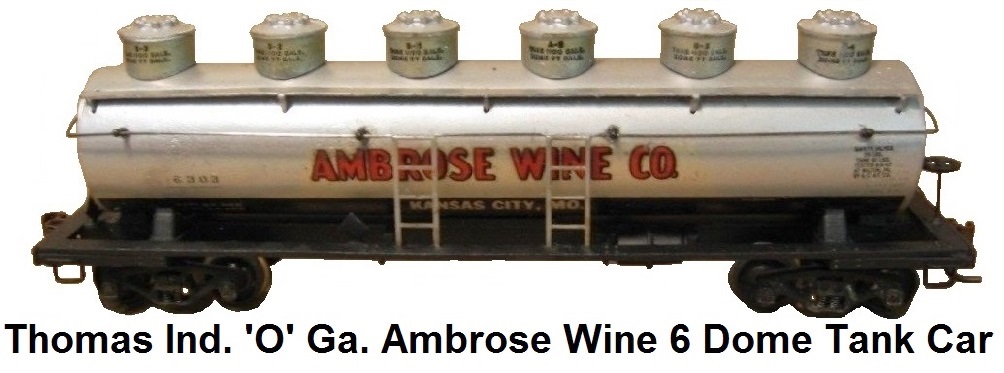


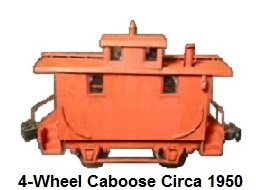
Thomas also made a Passenger Waiting Platform ($3.85), Goose-neck Lampost ($1.30), Boulevard Lampost ($.85), and
Switch Throw accessories. Thomas also produced parts for a number of other manufacturers including
the Ribbonrail track-cleaning flat car and the U&R Manufacturing Company's passenger cars.
Thomas made a pickup slide for an 'O' gauge 1000 HP EMD diesel switcher manufactured by General Models
Corp. (GMC) that was unmarked except for the Thomas name on the slide, which has
confused collectors as to who made this diesel locomotive. The Thomas knuckle couplers, which mated with
Lionel and Kusan trains, and the Thomas cast trucks ($2.10) were used by a good number of other
train makers as well.
One scientific item that Thomas Industries was famous for building was the Spitz Model A Planetarium beginning in 1946.
The Model A was invented by Professor Armand N. Spitz, who was the Director of Education at the Franklin Institute of Philadelphia. Spitz wanted
to make a planetarium that would be affordable to the consuming public. To build the the projector's base and planet drum he brought his hand
drawings to Jim Thomas of Thomas Industries of Wenonah, NJ. At this time Thomas Industries specialized in precision machining and were no strangers
to this type of prototype development. Within a couple months they were turning out the first production Spitz Model A machines. Armand then sold
them for $500 each. Up until the relocation to Oklahoma in 1951, Thomas Industries made the first 50 Model A series planetariums and about 40 of the
Model A-1 series planetariums for Armand.
Thomas continued to produce trains until 1958 when Jim Thomas died suddenly of a
heart attack at his home near Shawnee, OK on June 27th. He was 56 years of age. Other firms, including Thomas Industries Model
Trains of Plano, TX in 1962, continued production, until the dies and blueprints were destroyed in a fire in 1964.

